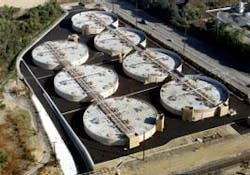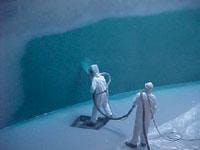New Coatings, Linings Help Meet Guidelines for Concrete Storage Tanks
By Bob Johnson
Preventing groundwater contamination from leaking above ground storage tanks (ASTs) is imperative for owners and operators of tanks containing industrial wastewater and hazardous materials. These tanks exist under the watchful eye of federal and state environmental agencies.
The U.S. Environmental Protection Agency's Spill Prevention and Control Countermeasures (SPCC) rule mandates performance standards for certain of these tanks storing hazardous waste. The Clean Water Act, Resource Conservation and Recovery Act (RCRA) and Oil Pollution Act also include regulations on ASTs.
At the state and local levels, regulations may be even more stringent. New rules passed in Minnesota, Florida, and other states focus on the prevention of spills and leaks as well as on containment. Failure to comply with this host of regulations can result in steep fines and penalties. The environmental and economic ramifications of even incidental leakage require that ASTs be effectively leak-free.
Concrete Tanks
Concrete is the most commonly used building material in wastewater containment because it has proven to be a low-cost, low-maintenance, high-strength structural material. Additionally, it is easy to work with and generally readily available. In a corrosive environment, however, concrete has its limitations. On its own, concrete cannot adequately resist all the chemicals it may be exposed to, or resist its natural tendency to crack due to shrinkage, temperature changes or substrate movement. Any of these potential hazards may result in structural compromise and leakage leading to ground water contamination.
As a result, concrete ASTs used for water treatment, industrial wastewater treatment, reservoirs and hazardous material containment are particularly susceptible to chemical effects and require special attention to protect the tank and prevent leaks or spills. To ensure their structural integrity and to protect the surrounding environment, reinforced concrete containment structures should meet ACI 350-01 "Code Requirements for Environmental Concrete Structures" set forth by the American Concrete Institute (ACI).
The design requirements for "a liquid-tight and gas-tight structure" state that where the concrete may be exposed to chemical effects beyond the protection capabilities of special cements and mineral admixtures, it must be protected by the use of coatings and linings as protective barrier systems.
The design of an appropriate protective lining system for concrete requires an understanding of the existing concrete (cracks, spalls, degradation, slope, contamination, etc.), the operating environment, the nature of the chemicals present, and the conditions of installation and use. Some coatings may be highly chemical-resistant but too rigid, others extremely elastic but more susceptible to corrosion in harsh conditions. Some coatings cannot be applied at temperature extremes; and still others may react with moisture or require an extended period to cure completely. The most effective system design will successfully pair project needs with coating system attributes.
Protective coatings and linings can provide erosion protection, crack-bridging capability and chemical resistance against potential contaminants and corrosive agents. From thin and medium film systems to composite laminate, mortar laminate and flexible laminate systems, corrosion control coatings and tank lining systems can accommodate the wide-ranging conditions found in environmental engineering concrete structures.
Coating and lining systems take advantage of the benefits of various resin chemistries. Recent advances in coating technology have produced new high solids epoxies, novolac epoxies, polyurethanes and polyureas with extreme elasticity and very low permeability. More user-friendly than their predecessors, today's protective coatings and linings can render a concrete containment structure virtually impermeable.
Crack-Bridging, Chemical Resistance
According to ACI guidelines, coatings and linings used in AST's "shall be able to bridge existing open cracks or joints in the substrate." In addition, they must be resistant to "chemical solutions or gases and biologically induced corrosion from bacteria, fungi and algae on the concrete elements." For concrete storage structures used in hazardous materials containment, ACI suggests that the "compatibility of the liner or coating material with the contents is the primary design consideration."
Flexible coating and lining systems are generally used in areas where the lining system is required to bridge cracks in concrete. Elastomeric epoxies, polyureas and polyurethanes often provide the resin basis for these flexible coating and lining systems due to their enhanced elongation properties.
Where additional chemical resistance is required, more rigid systems such as epoxies and novolac epoxies are often laminated to a flexible base coat laminate system, featuring fiber-reinforced fabrics or geotextiles. These systems, when used with mortar laminate or medium film, flake-filled epoxy toppings, will provide very good resistance to corrosive agents.
Selecting the resin system chemistry to meet the corrosive conditions present requires an analysis of the specific chemicals potentially in contact with the barrier system. The nature of the chemicals including their concentration and pH range is among the important considerations.
Epoxy novolac chemistry has advanced so that these materials can be used effectively in highly acidic environments. Unlike traditional styrene based systems, novolacs containing multi-functional epoxy resins are not sensitive to moisture and shrinkage and are lower in odor. Epoxy and novolac epoxy chemistries are available in low odor, zero VOC formulations and can cure at temperatures ranging from 35° F to 150°F.
The temperature and duration of chemical exposure is also important in determining the permeability requirements of the system. Glass, mica or graphite flake systems dramatically decrease system permeability and increase the service temperatures in which these systems can be used.
Reinforcing Fillers, Fabrics
Typically, tank lining systems used for corrosion control are resin-rich and use aggregate to build thickness, decrease the Coefficient of Linear Thermal Expansion (CLTE) of the system, provide for abrasion resistance or provide conductive properties where required. Particulate fillers are used primarily to reduce permeation and improve adhesion, but have the side benefit of reducing CLTE and providing for a marginal increase in the flexural and tensile strength of the resin systems.
For more dramatic flexural and tensile strength to resist shrinkage stress of the resins, thermal stress of the environment and structural stress from concrete movement, tank lining systems are typically laminated with fiber reinforced fabrics made up of fiberglass, nylon and polyester synthetics to produce structural chopped strand mats, woven roving fabrics, open weave scrim mats and light weight veils.
The chopped strand mats and woven roving fabrics are typically used as foundation layers for laminate lining systems. Reinforcing fibers are also layered into mortar laminate lining systems to provide moderate to heavy-duty protection in severe corrosive environments. Surface veils may be used on top of the resin saturated chopped strand mats and woven roving or on top of topping mortars to provide for a smoother, less permeable surface.
Compatibility Testing, Inspection
According to guidelines established in ACI 350-2R-17, "Concrete Structures for Containment of Hazardous Materials," compatibility tests between the contents of the AST and the lining system should be considered early in the design process. Testing "should simulate the actual operational conditions, pH, temperature, pressure and other service conditions as closely as possible." Manufacturer literature and case histories also provide good starting points for information.
Additional testing and inspection of the lining material is also recommended and "should start right after the selection of the manufacturer of the product and continue through its installation." Inspection methods may include hydrostatic tests to determine the integrity and liquid tightness of the tank prior to and after the application of a lining system, electric current or spark testing to verify the continuity of the lining system by identifying holidays or pinholes, and peel or bond tests to check the bond strength of coating systems to the substrate.
Other Tips
Proper surface preparation and professional installation of the corrosion control system are additional considerations as important as the design of the lining system itself. After the system has been installed, ongoing maintenance to ensure the integrity of the system as well as periodic inspection are generally necessary to preserve the manufacturer's warranty. Selecting the best chemistry for the corrosion control application should be done in consultation with the manufacturer.
Today's advanced technology resin lining systems meet the standards set by the ACI for protective barrier systems for hazardous material storage. When properly selected and installed, these concrete lining systems will preserve tank integrity and protect the surrounding environment.
About the Author: Bob Johnson is Director, ControlTech Marketing, for the Sherwin-Williams Co. A graduate of the University of South Florida, College of Engineering, over the past 31 years Johnson has held various management positions with Western Waterproofing, Master Builders Technologies, and The Sherwin-Williams Company. He is President of the International Concrete Repair Institute (ICRI); Chairman of NACE/SSPC/ICRI joint committee on Polymer Floor Systems and Past Chairman of ICRI committee on Coating & Waterproofing.




